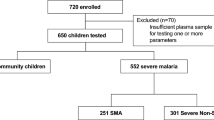Abstract
Anemia is a common and serious complication of malaria due to Plasmodium falciparum infection, a major health problem in tropical areas. Herein, the relation was investigated between the levels of circulating erythropoietin (EPO) and immunomodulatory cytokines in response to chloroquine treatment. Thirty-seven healthy control subjects and 40 patients with acute P. falciparum infection were included in the study. All subjects were adult male Sudanese. Blood samples were collected before chloroquine administration (25 mg/kg body weight, orally on three consecutive days) and 3 and 30 days after start of the therapy. Measurements included routine hematological parameters and the concentrations of immunoreactive EPO, tumor necrosis factor-α (TNF-α), interleukin 1α (IL-1), IL-6, and interferon γ (INF-γ). Chloroquine treatment led to a decrease in EPO levels in the control subjects but an increase in malaria patients at day 30. The latter was likely due to the anti-inflammatory action of the drug because INF-γ, IL-1, and IL-6 concentrations declined on chloroquine treatment. Based on these findings, we propose that an impaired EPO production in association with a prolonged elevation of certain inflammatory cytokines can contribute to the anemia in some malaria patients which can be reversed by chloroquine therapy.

Similar content being viewed by others
References
Brown AE, Webster HK, Teja IP, Keeratithakul D (1990) Macrophage activation in falciparum malaria as measured by neopterin and interferon-gamma. Clin Exp Immunol 82:97–101
Burchard GD, Radloff P, Philipps J, Nkeyi M, Knobloch J, Kremsner PG (1995) Increased erythropoietin production in children with severe malarial anemia. Am J Trop Med Hyg 53:547–551
Burgmann H, Looareesuwan S, Kapiotis S, Viravan C, Vanijanonta S, Hollenstein U et al (1996) Serum levels of erythropoietin in acute Plasmodium falciparum malaria. Am J Trop Med Hyg 54:280–283
Chang KH, Stevenson MM (2004) Effect of anemia and renal cytokine production on erythropoietin production during blood-stage malaria. Kidney Int 65:1640–1646 . doi:10.1111/j.1523-1755.2004.00573.x
Elamin SB, Malik EM, Abdelgadir T, Khamiss AH, Mohammed MM, Ahmed ES et al (2005) Artesunate plus sulfadoxine-pyrimethamine for treatment of uncomplicated Plasmodium falciparum malaria in Sudan. Malar J 4:41 . doi:10.1186/1475-2875-4-41
el-Hassan AM, Saeed AM, Fandrey J, Jelkmann W (1997) Decreased erythropoietin response in Plasmodium falciparum malaria-associated anaemia. Eur J Haematol 59:299–304
Fievet N, Moussa M, Tami G, Maubert B, Cot M, Deloron P et al (2001) Plasmodium falciparum induces a Th1/Th2 disequilibrium, favoring the Th1-type pathway, in the human placenta. J Infect Dis 183:1530–1534 . doi:10.1086/320201
Frisk-Holmberg M, Bergkvist Y, Domeij-Nyberg B, Hellstrom L, Jansson F (1979) Chloroquine serum concentration and side effects: evidence for dose-dependent kinetics. Clin Pharmacol Ther 25:345–350
Hemmer CJ, Kern P, Holst FG, Radtke KP, Egbring R, Bierhaus A et al (1991) Activation of the host response in human Plasmodium falciparum malaria: relation of parasitemia to tumor necrosis factor/cachectin, thrombin-antithrombin III, and protein C levels. Am J Med 91:37–44 . doi:10.1016/0002-9343(91)90071-5
Jelkmann W (1998) Proinflammatory cytokines lowering erythropoietin production. J Interferon Cytokine Res 18:555–559
Kurtzhals JA, Rodrigues O, Addae M, Commey JO, Nkrumah FK, Hviid L (1997) Reversible suppression of bone marrow response to erythropoietin in Plasmodium falciparum malaria. Br J Haematol 97:169–174 . doi:10.1046/j.1365-2141.1997.82654.x
Lamikanra AA, Brown DM, Potocnik A, Casals-Pascual C, Langhorne J, Roberts DJ (2007) Malarial anemia: of mice and man. Blood 110:18–28 . doi:10.1182/blood-2006-09-018069
Malik EM, Mohamed TA, Elmardi KA, Mowien RM, Elhassan AH, Elamin SB et al (2006) From chloroquine to artemisinin-based combination therapy: the Sudanese experience. Malar J 5:65 . doi:10.1186/1475-2875-5-65
McDevitt MA, Xie J, Gordeuk V, Bucala R (2004) The anemia of malaria infection: role of inflammatory cytokines. Curr Hematol Rep 3:97–106
Means RT, Krantz SB (1992) Progress in understanding the pathogenesis of the anemia of chronic disease. Blood 80:1639–1647
Nussenblatt V, Mukasa G, Metzger A, Ndeezi G, Garrett E, Semba RD (2001) Anemia and interleukin-10, tumor necrosis factor alpha, and erythropoietin levels among children with acute, uncomplicated plasmodium falciparum malaria. Clin Diagn Lab Immunol 8:1164–1170 . doi:10.1128/CDLI.8.6.1164-1170.2001
Tagelsir N, Ibrahim Z, Medani A, Salih O, Hamad A, Giha H et al (2006) High frequency of Plasmodium falciparum PfCRT K76T and PfpghN86Y in patients clearing infection after chloroquine treatment in the Sudan. Acta Trop 97:19–25 . doi:10.1016/j.actatropica.2005.07.030
Verhoef H, West CE, Kraaijenhagen R, Nzyuko SM, King R, Mbandi MM et al (2002) Malarial anemia leads to adequately increased erythropoiesis in asymptomatic Kenyan children. Blood 100:3489–3494 . doi:10.1182/blood-2001-12-0228
Weatherall DJ, Abdalla S (1982) The anaemia of Plasmodium falciparum malaria. Br Med Bull 38:147–151
Weiss G, Goodnough LT (2005) Anemia of chronic disease. N Engl J Med 352:1011–1023 . doi:10.1056/NEJMra041809
Wenisch C, Parschalk B, Narzt E, Looareesuwan S, Graninger W (1995) Elevated serum levels of IL-10 and IFN-gamma in patients with acute Plasmodium falciparum malaria. Clin Immunol Immunopathol 74:115–117 . doi:10.1006/clin.1995.1017
Word Health Organisation (1968) Nutritional anaemias. Report of a WHO scientific group.405:5–37
Acknowledgment
Supported by DAAD, grant No. A/99/04652.
Author information
Authors and Affiliations
Corresponding author
Rights and permissions
About this article
Cite this article
Ballal, A., Saeed, A., Rouina, P. et al. Effects of chloroquine treatment on circulating erythropoietin and inflammatory cytokines in acute Plasmodium falciparum malaria. Ann Hematol 88, 411–415 (2009). https://doi.org/10.1007/s00277-008-0636-z
Received:
Accepted:
Published:
Issue Date:
DOI: https://doi.org/10.1007/s00277-008-0636-z




